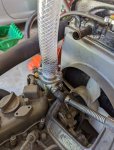I would suggest that is not a valid test.UPDATE: to see if the water pump had failed, I temporarily replaced the upper radiator hose with a clear one and removed the thermostat. The coolant was NOT flowing. Does this mean the water pump is bad OR will coolant not flow right away after start up? I left it idling a minute or two and NO flow...
Without thermostat, the coolant is free to flow ANY direction it wants..... the direction of least resistance is thru the 'bypass' pipe back into the engine. (thus bypassing the radiator)
QUESTION: With that clear section of pipe TOTALLY FULL of liquid... how could you tell if there is any flow anyway?? .... you are not expecting the waterpump to 'lift' coolant up the pipe into the radiator, are you?
(the waterpump is designed to MOVE liquid in a totally-full system... it is not really capable of 'lifting' uphill)
With thermostat installed, it is often possible to leave the radiator-cap off and see the flow as slight ripples The fluid in the radiator will do pretty-much nothing until the the thermostat starts to open... then you should see some flow.
.... but using 'point-n-shoot' thermometer gives you more information.
DO NOT remove radiator cap with hot engine without first squeezing top hose to validate there is no pressure.


